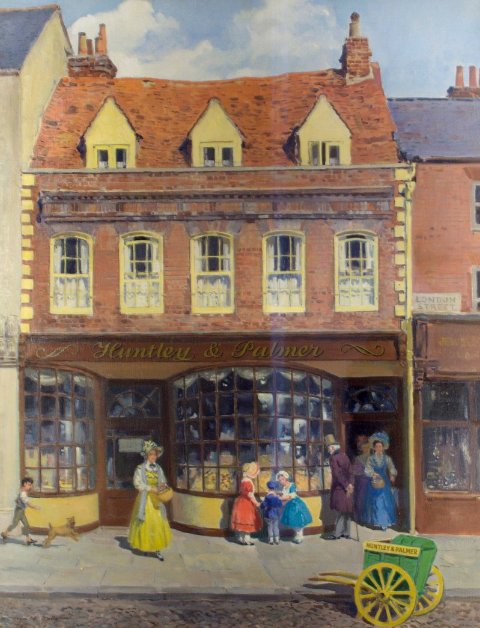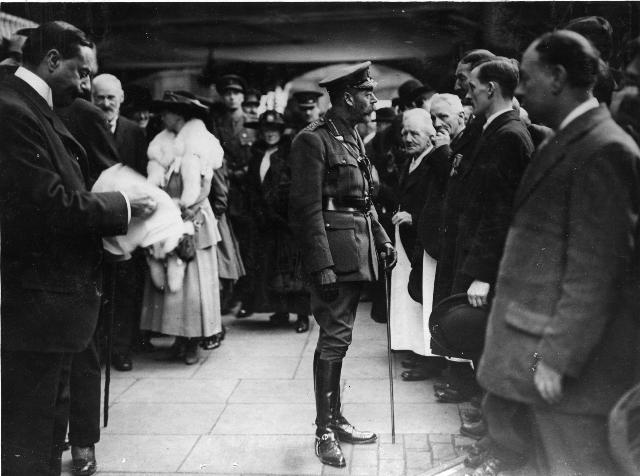Written by Anna Jones, Programme Manager of Museums Partnership Reading
'If you're trying to create a company, it's like baking. You have to have all the ingredients in the right proportion'.
Tech entrepreneur and space cadet Elon Musk could have sourced his business analogy from Reading's history. For in 1822, Joseph Huntley literally and metaphorically mixed ingredients and cooked up one of the most famous names in baking history: Huntley & Palmers.
The beginnings of Huntley & Palmers
After receiving an inheritance following the death of his wife, Joseph Huntley, a Quaker schoolmaster from Oxfordshire, established a small baker’s shop at 72 London Street, Reading. His son Thomas joined as a partner in 1829, and the firm became known as Joseph Huntley & Son. In 1841, this partnership grew to include George Palmer, a fellow Reading Quaker and later MP for Reading, and the burgeoning biscuit business was renamed Huntley & Palmers. The rest, as they say, is history. And biscuits. And lots of them.

This painting by Reginald Mills depicts the baker's shop in which Joseph Huntley and his son Thomas started making biscuits in 1822. When George Palmer joined the firm in 1841 all the biscuits were produced in the back room of this shop. REDMG : 1968.139
Opening the first factory, and global fame
In 1846, Huntley & Palmers opened a large factory on Kings Road, Reading. Palmer scaled and transformed the business, developing the first continuously running machine for making biscuits, which proved pivotal to the company's successes, as it soon became the largest biscuit manufacturer in the world.
Within forty years, the company that created the Nice biscuit, Gingernut and the Bath Oliver, was exporting its goods across the globe, employing more than 5,000 workers, and enjoying a prestigious and elite reputation among the forty most important industrial companies in Britain.
As Huntley & Palmers became one of the first global brands selling the ‘Number One in Biscuits and Second-to-None in Cakes’ to 137 countries at its peak, so too did Reading become known as the Biscuit Town.

In 1918, King George V visited the Huntley & Palmers factory. During the war, like so many parts of British industry, H&P pivoted from producing their usual wares to munitions. REDMG : 1997.120.268.2
Delicious designs
Success and innovation went beyond what was consumed. The brand’s tins, originally created for practical airtight storage, ensuring produce stayed oven-fresh and unbroken, became iconic in their own right.
Award-winning designs, including the first hinged and printed biscuit tins, became as highly prized as the goodies they contained. Huntley & Palmers’ Reading factory stopped manufacturing in 1972, and today the tins are collectors’ items.
Below, take a look at two Huntley & Palmers tins newly uploaded in full 3D to the Reading Museum Sketchfab account.
- The Waverley Tin: a design in the shape of bound books, each by Sir Walter Scott.
- The Pearl Divers Tin: a design depicting a scene of Japanese pearl divers, featuring a humorous and rather outrageous flourish by legendary tin designer Mick Hill.
The astonishing collection of objects and ephemera in the Huntley & Palmers Gallery at Reading Museum features almost 300 decorative biscuit tins, including the rude ‘Kate Greenaway’ biscuit tin that embarrassed the biscuit company in 1980. We'll be highlighting the story of this tin on our blog very soon.

From one Reading partnership to another
This year, we are marking the special anniversary of 200 years of Reading's biscuit heritage through another Reading creative partnership; albeit one based not in the kitchen or the tin, but in museum objects, galleries, and the joy of learning about our shared past.
Museums Partnership Reading is a joint programme of events, exhibitions and activities from The MERL and Reading Museum, funded by Arts Council England. For Biscuit Town 200, we will be running a special exhibition (Biscuit Town: 200 Years of Huntley & Palmers in Reading, displayed at The MERL), guided tours, themed family events, and afternoon teas (complete, of course, with biscuits), all exploring this special biscuit history at the heart of our town.

What's on
- A special exhibition, Biscuit Town: 200 years of Huntley and Palmers in Reading, runs at The Museum of English Rural Life from 10th May to 25th September 2022. It explores Huntley & Palmers’ impact on the growth of Reading and examines the company’s international reach. The exhibition takes a more personal look at some of the people impacted by the company’s development, including those working at the innovative King’s Road factory. These stories will be illustrated by a selection of gems from the Huntley & Palmer’s Archive in the University of Reading Special Collections, such as photographs, packaging, catalogues and more. The MERL is located within what was once Alfred Palmer’s family home, with this exhibition located in the beautiful Victorian staircase hall.
- A film commissioned by the AHRC-funded Everyday Lives in War will be shared: 'Unsweetened: Ode to Biscuits'. Museums Partnership Reading collaborated with filmmakers Teresa Murjas and James Ratee on the film, and hosted the premiere screening at Reading Biscuit Factory in March. 'Unsweetened' is a meditation on Huntley & Palmers' factory at the dawning of the First World War. Themes include local and global hidden histories; social attitudes to conscientious objection; health, disability, and medicine; children’s working experiences; and food supply.
- A new leaflet will help you explore Reading’s biscuit heritage at your own pace. Pick up a copy of the self-guided Biscuit Crumb Trail at the museums and across the town.
- A new Huntley & Palmers audio trail will be available from June. Take a journey through time and the world of biscuits with this fascinating guided history. Real and imagined voices and sounds tell the story of how Huntley & Palmers grew from London Street into a global powerhouse. This is produced as part of Reading's High Street Heritage Action Zone (HSHAZ), delivered in collaboration with Museums Partnership Reading.
- Reading Children’s Festival (14th May to 5th June) will be taking on the theme of Biscuit Town. This year's festival celebrates its 33rd anniversary with three fun-packed weeks of events and activities for children all over the borough. Museums Partnership Reading will be part of the festival's action-packed start at the Forbury Fiesta on Saturday 14th May, where there will be a whole host of biscuit related activities. Join Alice and the Mad Hatter for a tea part with a twist, be entertained by the biscuit choir, create your own biscuit hat, and join in the biscuit parade.
- And new digital content by Museums Partnership Reading will highlight and share significant stories and moments from the company's incredible history.
Needless to say: Elon would be a smart cookie to swap the stratosphere for Reading for his travels this year.
Find out more
Biscuit Town 200 is made possible through the generous support of a range of local and regional partners, including Arts Council England and the Great Western Railway, our Official Travel Partner. Find out more about the full programme taking place across Reading in this Visit Reading news post.
With thanks to the University of Reading's Special Collections for supplying the header image of this post (object number HP/55).
Anna Jones is Programme Manager for Museums Partnership Reading, and Cultural Activities Facilitator for Reading's High Street Heritage Action Zone.





